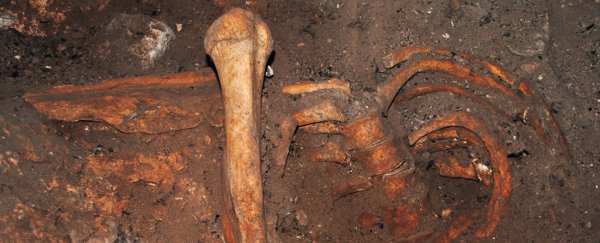Scientists have successfully sequenced genes from people who lived in Africa some 15,000 years ago – and what they found casts new light on the way communities moved and interacted as far back as the end of the Stone Age.
Understanding the history of North Africa is crucial in mapping out how human beings spread out across the continent and the rest of the world, but up until now experts have had very little genetic material to reference.
Ordinarily, DNA from remains this old would be degraded beyond reach, but researchers applied some advanced lab methods and new analysis techniques to recover ancient genomes, at least in part, from the remains of nine people who died in Morocco approximately 15,000 years ago.
The new DNA data is in fact the oldest human DNA evidence ever fully analysed from Africa, and suggests humans from North Africa, sub-Saharan Africa and the Middle East interacted much earlier than we thought.
"A better understanding of the history of North Africa is critical to understanding the history of our species," says one of the team, Saaïd Amzazi from Mohammed V University in Morocco.
Northwest Africa has the Mediterranean sea to the north and the Sahara desert to the south – both fairly effective barriers against populations spreading out tens of thousands of years ago.
Or so you would think.
But DNA similarities between the samples found in Morocco, and genetic data from sub-Saharan African and from the Levantine Natufians of the Eastern Mediterranean, suggests maybe people weren't quite as boxed in as scientists thought.
While similar to these other communities in part, the genetic markers found in the people of Taforalt didn't give a complete match to any genomes on record.
That leaves experts guessing as to where exactly this population originated from.
There was also no genetic link to ancient Europeans from Sicily or southern Spain, something else historians had wondered about.
It would seem people of those areas weren't mixing at this time – at least based on these samples.
 Small stone tools known as microliths. (Abdeljalil Bouzouggar)
Small stone tools known as microliths. (Abdeljalil Bouzouggar)
The researchers focused on a burial site in Grotte des Pigeons, near the Moroccan village of Taforalt. It's actually the oldest known cemetery in the world, so rich pickings for researchers interested in the genetic characteristics of ancient peoples.
"Grotte des Pigeons is a crucial site to understanding the human history of northwestern Africa, since modern humans frequently inhabited this cave intensively during prolonged periods throughout the Middle and Later Stone Age," says one of the researchers, Louise Humphrey from the Natural History Museum in the UK.
The Stone Age communities who lived here are thought to have been among the first to make use of small stone tools known as microliths. This was before the agricultural revolution in North Africa, which happened about 10,000 years ago.
Further research could help experts discover more about the lineages of the people who lived and died in Taforalt, but already we're seeing ways that modern genetic analysis can be used to shine a light on how people moved across the planet thousands of years ago.
And it's not an isolated incident either – earlier this year, tests on ancient DNA revealed a population of Native Americans that historians had previously known nothing about.
"This illustrates the ability of ancient genetics to add to our understanding of human history," says one of the team behind the new research, Johannes Krause from the Max Planck Institute for the Science of Human History in Germany.
"Clearly, human populations were interacting much more with groups from other, more distant areas than was previously assumed."
The research has been published in Science.
